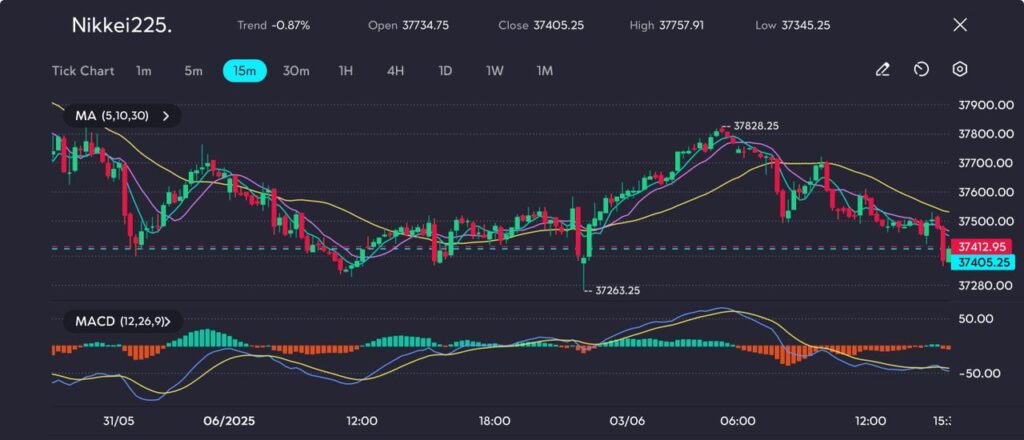
The Japanese stock market faced renewed pressure on Tuesday as cautious investor sentiment took hold, driven by a stronger yen and ongoing global trade uncertainties. While individual corporate headlines made waves, broader concerns about currency movements and geopolitical tensions dominated market focus.
The Nikkei 225 extended its decline for a third consecutive session on Tuesday, finishing slightly lower at 37,446.81, down 0.06%, after reversing early gains.
Despite the limited drop, investor sentiment across the Tokyo Stock Exchange remained cautious, with a broader bias towards selling—122 stocks declined, compared to 98 gainers and five unchanged.
The primary pressure on the index came from a strengthening Japanese yen, which appreciated to a one-week high of ¥142.40 against the US dollar.
A stronger yen typically dents the profitability of Japan’s export-driven firms by reducing the value of overseas earnings when converted back to yen.
Automotive stocks were particularly affected. Suzuki Motor recorded the sharpest fall within the index, dropping 4.51%, while Honda shed 0.94% and industry leader Toyota declined 0.59%.
This was despite reports in the domestic media of a potential $42 billion acquisition of Toyota Industries, which saw a modest rise of 0.77%.
These market movements highlight how traders are prioritising macroeconomic headwinds and currency developments over isolated corporate news.
Investors are also increasingly wary of escalating trade tensions, particularly between the United States and China.
According to Reuters, the Trump administration has imposed a deadline for countries to submit final proposals by Wednesday as part of ongoing trade talks. This effort aims to fast-track progress ahead of a self-imposed deadline in five weeks.
Further uncertainty was introduced by news that Donald Trump and Chinese President Xi Jinping may hold discussions later this week, following recent accusations from Trump that China breached previous trade rollback agreements.
This fragile diplomatic backdrop is unsettling markets, particularly in Japan, where economic growth is closely tied to exports.
Any renewed friction could prompt retaliatory tariffs or supply chain disruptions—risks that equity markets are keen to avoid.
Although overall market volatility appears subdued, price action in the Nikkei remains vulnerable.
Every attempt at a rebound this week has been met with selling pressure. The index continues to face resistance in the 37,800–37,850 range, while immediate support lies around 37,250.
On 3 June, the Nikkei briefly rallied from an intraday low of 37,263.25 to a high of 37,828.25, supported by short-term momentum across the 5-, 10-, and 30-period moving averages.
However, that bullish impulse has now faded, with prices slipping back below the 30-MA.

The MACD indicator confirms this shift in momentum, with a bearish crossover and movement into negative territory, suggesting a deeper pullback may be in play.
Price is currently testing key support near 37,400, and a decisive break below this level could open the door to a retest of the 37,260–37,300 zone.
For the bulls to regain control, the index would need to reclaim ground above 37,600–37,800.
However, without a reversal in yen strength or improvement in trade-related news, Japanese equities are likely to remain under pressure in the near term.
Click here to open account and start trading.